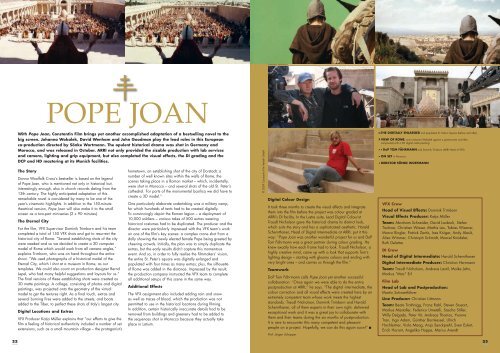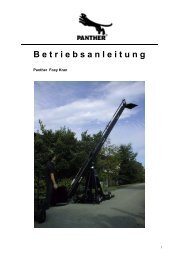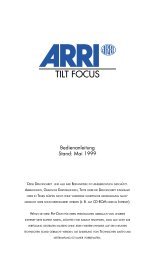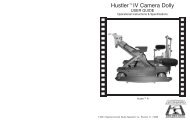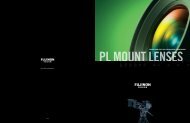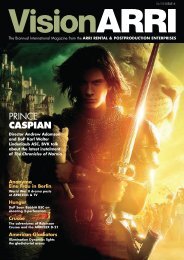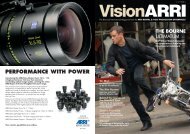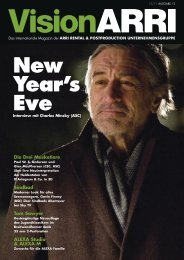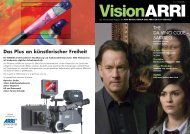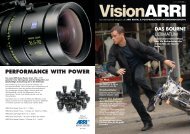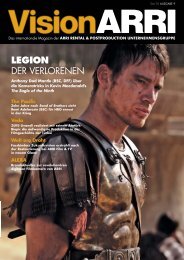Download English (PDF, 3.17MB) - ARRI Rental
Download English (PDF, 3.17MB) - ARRI Rental
Download English (PDF, 3.17MB) - ARRI Rental
You also want an ePaper? Increase the reach of your titles
YUMPU automatically turns print PDFs into web optimized ePapers that Google loves.
12<br />
The light at the end<br />
of the tunnel<br />
DIRECTOR ANNO SAUL<br />
Vision<strong>ARRI</strong>: For your new film, The Door, you<br />
surrounded yourself with many familiar faces.<br />
How did the project come about?<br />
Anno Saul: Ralph Schwingel, Jan Berger and I always<br />
wanted to do a follow-up project to Kebab Connection,<br />
which Jan and I had co-written. At some point Jan<br />
pitched a project to me that Björn Vosgerau – a<br />
producer at Wüstefilm – had approached him with. That<br />
project was The Door, based on the novel Die Damalstür<br />
by Akif Pirinçci, and I immediately responded to the<br />
material. Now all we had to do was convince Ralph<br />
Schwingel at Wüstefilm, who had some concerns.<br />
Among other things, he thought that the main character<br />
in the novel wasn’t likable. But we made the necessary<br />
changes and also altered the ending of the film.<br />
VA: What is The Door about?<br />
AS: It’s the story of a man who has made a big mistake<br />
in his life. He had a beautiful home, a lovely wife and<br />
an adorable daughter. But returning from the house of<br />
a neighbour with whom he has just had a sexual<br />
encounter, he finds his daughter dead in the pool; she<br />
has drowned. In the events that follow he loses his wife<br />
and their home, and then we fast-forward: four years<br />
later he’s completely washed up, very unhappy and<br />
wants to die. During one of his futile attempts to take his<br />
life, he by chance discovers a tunnel behind a bush and<br />
goes into it. He walks towards a light at the end of<br />
tunnel and finds a door. Opening it, he steps into a<br />
world that looks very much like his old life – a time<br />
when he was still very happy. He watches the younger<br />
version of himself walk over to the neighbour’s house<br />
and realises that he has a chance to make up for his<br />
mistake and rescue his daughter. Then, in a fatal turn of<br />
events, he encounters his younger self.<br />
VA: So, the basic theme of The Door is<br />
redemption; the opportunity to revisit one’s<br />
past and alter the course of one’s destiny?<br />
AS: Exactly. The film contains two separate yet parallel<br />
worlds. The characters in both are the same, but<br />
displaced by four and a half years. One of these worlds<br />
– that of the older, suicidal character – is a wintery,<br />
extremely cold and dark world. The world that existed<br />
the day of his daughter’s death is a bright and sunny,<br />
summery world.<br />
VA: Did you create the bright and the dark<br />
worlds in-camera?<br />
AS: No, we could only create this duality during<br />
grading. The wintery world was graded normally but<br />
the summery world we cross-processed, to get more<br />
contrast. The light parts came out even lighter and the<br />
dark parts even darker. Overall, the colours came out<br />
more desaturated; we got a grittier look that way, an<br />
effect we increased the further we got into the story.<br />
That was our visual concept. We also picked up the<br />
pacing. The Door’s structure escalates; everything in<br />
the film escalates over the course of time.<br />
VA: Florian (Utsi) Martin was your colourist on<br />
The Door. What do you consider an ideal<br />
collaboration during grading?<br />
AS: Ideally, the colourist makes an effort to understand<br />
what it is the director and the DoP want to accomplish,<br />
and then implements that vision technically and<br />
creatively. Grading is an important part<br />
of the creative process and therefore of<br />
the language of film. This language, as<br />
well as the entire range of technological<br />
possibilities, has to be put to use in the<br />
service of the story the film is trying to<br />
tell, not in the service of current trends in<br />
terms of what is ‘hip.’ The collaboration<br />
with Utsi Martin was fantastic and<br />
mutually enriching. Colour matching was<br />
very important on The Door. First came<br />
the broad strokes, then we went in and<br />
worked out the details.<br />
VA: Was this your first<br />
collaboration with<br />
cinematographer Bella Halben?<br />
AS: Yes, and I enjoyed it very much. Bella<br />
is an extremely competent DoP – highly<br />
talented and a great person; very<br />
creative and effervescent. Hundreds of<br />
her ideas made it into The Door.<br />
VA: After directing comedies such<br />
as Where is Fred? and Kebab<br />
Connection, how did you end up<br />
in this genre and with such a<br />
serious story?<br />
AS: Prior to the two comedies, I made<br />
Green Desert, which is also a drama.<br />
When Ralph Schwingel submitted<br />
Kebab Connection for funding, he was<br />
asked why he had chosen me to direct<br />
the film because they considered me to<br />
be a drama director. Now I’m only good<br />
for comedies? No, I like to dabble in<br />
different genres and to play with their<br />
parameters – that’s what’s challenging.<br />
VA: Have you ever shot digitally or<br />
are you planning to?<br />
AS: In the last couple of years I’ve<br />
watched several student films that were<br />
shot in HD and I was impressed by how<br />
great they looked. But students have a lot<br />
of time to fiddle with things and to work<br />
on the look they are going for. Personally,<br />
I still feel that film has an imperfect yet<br />
vibrant quality. And there is something<br />
else that’s essential for me: I have to be<br />
able to rely on the equipment; for<br />
example, I shot three TV movies in<br />
Sweden and learned that cameras can’t<br />
ever malfunction – period! It’s a<br />
catastrophe when they do. You’ll lose<br />
three days of shooting if you are in<br />
Gotland or somewhere in the backwoods.<br />
To me, that means taking equipment that<br />
has been refined over the last 30 years;<br />
that just keeps running and won’t quit<br />
when water gets in or when it gets<br />
extremely cold; equipment that won’t let<br />
you down – like the <strong>ARRI</strong> cameras. Sure,<br />
when I’m in Cologne I can get another<br />
camera within an hour, but not in Gotland.<br />
VISION<strong>ARRI</strong><br />
VA: Why do you like working<br />
with <strong>ARRI</strong>?<br />
AS: When I was in film school I worked<br />
with <strong>ARRI</strong> and I made my first feature<br />
there. I went to <strong>ARRI</strong> whenever I could.<br />
It wasn’t always possible, but if I had a<br />
say, I chose <strong>ARRI</strong>. I prefer it because it’s<br />
where I get the best support. At <strong>ARRI</strong><br />
you’re surrounded by people who not<br />
only know what they are talking about<br />
and support the filmmakers and their<br />
projects, but they also love cinema! The<br />
people at <strong>ARRI</strong> always do everything<br />
possible to ensure that your film comes<br />
out as good as it possibly can and the<br />
size of the budget never matters – their<br />
dedication is always equally high!<br />
VA: We wish you the best of luck<br />
and a great turnout for the fall<br />
release of The Door.<br />
The Door is a Wüstefilm / Wüstefilm Ost<br />
production co-produced with Senator Film<br />
Produktion. The film was released<br />
theatrically on November 12, 2009.<br />
For more information, please visit Senator<br />
Filmverleih (www.senator.de). ■<br />
Katja Birkenbach<br />
13<br />
Photos © Senator Film


